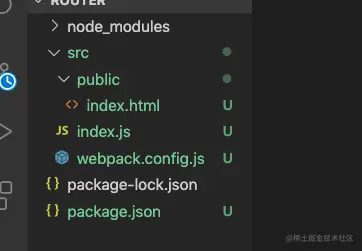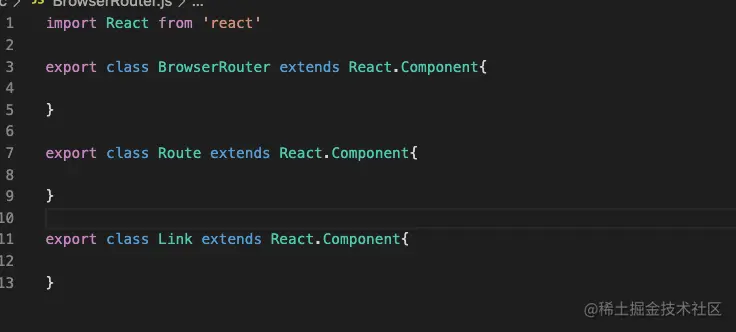在单页面应用如日中天发展的过程中,备受关注的少了前端路由。
而且还经常会被 xxx 面试官问到,什么是前端路由,它的原理的是什么,它是怎么实现,跳转不刷新页面的...
一大堆为什么,问你头都大
前言
今天主要讲的是:
四种路由的实现原理。
环境问题
因为等一下要用到 h5 新增的 pushState() 方法,因为这玩(diao)意(mao)太矫情了,不支持在本地的 file 协议运行,不然就会报以下错误
只可以在 http(s)协议 运行,这个坑本渣也是踩了很久,踩怀疑自己的性别。
既然用 file 协议 不行那就只能用 webpack 搭个简陋坏境了,你也可以用阿帕奇,tomcat...啊狗啊猫之类的东西代理。
本渣用的是 webpack 环境,也方便等下讲解 react-router-dom 的两个路由的原理。环境的配置,我简单的贴一下,这里不讲。
npm i webpack webpack-cli babel-loader @babel-core @babel/preset-env html-webpack-plugin webpack-dev-server -D
复制代码
webpack.config.js
const path = require('path')
const HtmlWebpackPlugin = require('html-webpack-plugin')
module.exports = {
entry:path.resolve(__dirname,'./index.js'),
output:{
filename:'[name].[hash:6].js',
path:path.resolve(__dirname,'../dist')
},
module:{
rules:[ { test:/\.js$/,
exclude:/node_module/,
use:[ { loader:'babel-loader', options:{ presets:['@babel/preset-env'] } } ] } ]
},
plugins:[ new HtmlWebpackPlugin({ template:path.resolve(__dirname,'./public/index.html'), filename:'index.html' }) ]
}
复制代码
package.json 的 script 添加一条命令
"dev":"webpack-dev-server --config ./src/webpack.config.js --open"
复制代码
项目目录
运行
现在所有东西都准备好了,我们可以进入主题了。
原生 js 实现 hashRouter
html
<ul> <li><a href='#/home'>home</a></li> <li><a href='#/about'>about</a></li> <div id="routeView"></div></ul>
复制代码
js
window.addEventListener('DOMContentLoaded', onLoad)
window.addEventListener('hashchange', changeView)
let routeView = ''
function onLoad() {
routeView = document.getElementById('routeView')
changeView()
}
function changeView() { switch (location.hash) { case '#/home': routeView.innerHTML = 'home' break; case '#/about': routeView.innerHTML = 'about' break; }
}
复制代码
原生 js 实现 hashRouter 主要是监听它的 hashchange 事件的变化,然后拿到对应的 location.hash 更新对应的视图
原生 js 实现 historyRouter
html
<ul> <li><a href='/home'>home</a></li> <li><a href='/about'>about</a></li> <div id="routeView"></div></ul>
复制代码
historyRoute
window.addEventListener('DOMContentLoaded', onLoad)
window.addEventListener('popstate', changeView)
let routeView = ''
function onLoad() {
routeView = document.getElementById('routeView')
changeView()
let event = document.getElementsByTagName('ul')[0]
event.addEventListener('click', (e) => {
if(e.target.nodeName === 'A'){ e.preventDefault()
history.pushState(null, "", e.target.getAttribute('href'))
changeView() }
})}
function changeView() { switch (location.pathname) { case '/home': routeView.innerHTML = 'home' break; case '/about': routeView.innerHTML = 'about' break; }
}
复制代码
能够实现 history 路由跳转不刷新页面得益与 H5 提供的 pushState(),replaceState()等方法,这些方法都是也可以改变路由状态(路径),但不作页面跳转,我们可以通过 location.pathname 来显示对应的视图
react-router-dom
react-router-dom 是 react 的路由,它帮助我们在项目中实现单页面应用,它提供给我们两种路由一种基于 hash 段实现的 HashRouter,一种基于 H5Api 实现的 BrowserRouter。
下面我们来简单用一下。
如果你在用本渣以上提供给你的环境,还要配置一下,下面👇这些东西,如果不是,请忽略。
npm i react react-dom react-router-dom @babel/preset-react -D
复制代码
webpack.config.js,在 js 的 options 配置加一个 preset
将 index.js 改成这样。
import React from 'react'
import ReactDom from 'react-dom'
import { BrowserRouter, Route, Link } from 'react-router-dom'
function App() {
return (
<BrowserRouter> <Link to='/home'>home</Link> <Link to='/about'>about</Link> <Route path='/home' render={()=><div>home</div>}></Route> <Route path='/about' render={()=><div>about</div>}></Route> </BrowserRouter>
)}
ReactDom.render(<App></App>,document.getElementById('root'))
复制代码
public/index.html
平时我么只知道去使用它们,但却很少去考虑它是怎么做到,所以导致我们一被问到,就会懵逼;今日如果你看完这篇文章,本渣 promiss 你不再只会用 react-router,不再是它骑在你身上,而是你可以对它为所欲为。
react-router-dom 的 BrowserRouter 实现
首先我们在 index.js 新建一个 BrowserRouter.js 文件,我们来实现自己 BrowserRouter。 既然要实现 BrowserRouter,那这个文件就得有三个组件 BrowserRouter,Route,Link。
好,现在我们把它壳定好来,让我们来一个一个的弄*它们😂
BrowserRouter 组件
BrowserRouter 组件主要做的是将当前的路径往下传,并监听 popstate 事件,所以我们要用 Consumer, Provider 跨组件通信,参考 React 实战视频讲解:进入学习
const { Consumer, Provider } = React.createContext()
export class BrowserRouter extends React.Component {
constructor(props) { super(props) this.state = { currentPath: this.getParams.bind(this)(window.location.pathname) } }
onChangeView() { const currentPath = this.getParams.bind(this)(window.location.pathname) this.setState({ currentPath }); };
getParams(url) { return url }
componentDidMount() { window.addEventListener("popstate", this.onChangeView.bind(this)); }
componentWillUnmount() { window.removeEventListener("popstate", this.onChangeView.bind(this)); }
render() { return ( <Provider value={{ currentPath: this.state.currentPath, onChangeView: this.onChangeView.bind(this) }}> <div> { React.Children.map(this.props.children, function (child) {
return child
}) } </div> </Provider> ); }}
复制代码
Rouer 组件的实现
Router 组件主要做的是通过 BrowserRouter 传过来的当前值,与 Route 通过 props 传进来的 path 对比,然后决定是否执行 props 传进来的 render 函数,
export class Route extends React.Component {
constructor(props) { super(props) }
render() { let { path, render } = this.props return ( <Consumer> {({ currentPath }) => currentPath === path && render()} </Consumer> ) }}
复制代码
Link 组件的实现
Link 组件主要做的是,拿到 prop,传进来的 to,通过 PushState()改变路由状态,然后拿到 BrowserRouter 传过来的 onChangeView 手动刷新视图
export class Link extends React.Component {
constructor(props){ super(props) }
render() { let { to, ...props } = this.props return ( <Consumer> {({ onChangeView }) => ( <a {...props} onClick={e => { e.preventDefault(); window.history.pushState(null, "", to); onChangeView(); }} /> )} </Consumer> )
}
}
复制代码
完整代码
import React from 'react'
const { Consumer, Provider } = React.createContext()
export class BrowserRouter extends React.Component {
constructor(props) { super(props) this.state = { currentPath: this.getParams.bind(this)(window.location.pathname) } }
onChangeView() { const currentPath = this.getParams.bind(this)(window.location.pathname) this.setState({ currentPath }); };
getParams(url) { return url }
componentDidMount() { window.addEventListener("popstate", this.onChangeView.bind(this)); }
componentWillUnmount() { window.removeEventListener("popstate", this.onChangeView.bind(this)); }
render() { return ( <Provider value={{ currentPath: this.state.currentPath, onChangeView: this.onChangeView.bind(this) }}> <div> { React.Children.map(this.props.children, function (child) {
return child
}) } </div> </Provider> ); }}
export class Route extends React.Component {
constructor(props) { super(props) }
render() { let { path, render } = this.props return ( <Consumer> {({ currentPath }) => currentPath === path && render()} </Consumer> ) }}
export class Link extends React.Component {
constructor(props){ super(props) }
render() { let { to, ...props } = this.props return ( <Consumer> {({ onChangeView }) => ( <a {...props} onClick={e => { e.preventDefault(); window.history.pushState(null, "", to); onChangeView(); }} /> )} </Consumer> )
}
}
复制代码
使用
把刚才在 index.js 使用的 react-router-dom 换成这个文件路径就 OK。
react-router-dom 的 hashRouter 的实现
hashRouter 就不一个一个组件的说了,跟 BrowserRouter 大同小异,直接贴完整代码了
import React from 'react'
let { Provider, Consumer } = React.createContext()
export class HashRouter extends React.Component { constructor(props) { super(props) this.state = { currentPath: this.getCurrentPath.bind(this)(window.location.href) } }
componentDidMount() { window.addEventListener('hashchange', this.onChangeView.bind(this)) }
componentWillUnmount() { window.removeEventListener('hashchange') }
onChangeView(e) { let currentPath = this.getCurrentPath.bind(this)(window.location.href) this.setState({ currentPath }) }
getCurrentPath(url) {
let hashRoute = url.split('#')
return hashRoute[1] }
render() {
return (
<Provider value={{ currentPath: this.state.currentPath }}> <div> { React.Children.map(this.props.children, function (child) {
return child
}) } </div> </Provider>
)
}
}
export class Route extends React.Component {
constructor(props) { super(props) }
render() {
let { path, render } = this.props
return ( <Consumer> { (value) => { console.log(value) return ( value.currentPath === path && render() ) } } </Consumer> )
}
}
export class Link extends React.Component {
constructor(props) { super(props) }
render() {
let { to, ...props } = this.props
return <a href={'#' + to} {...props} />
}
复制代码














评论